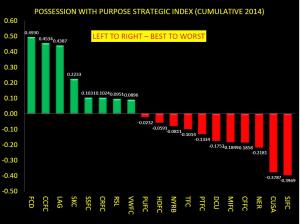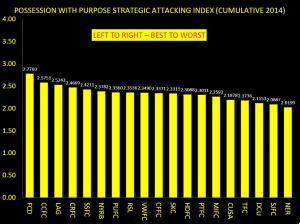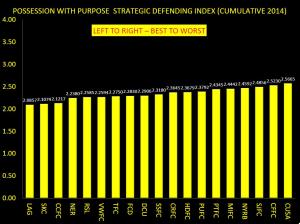And so it goes; another week completed where you got the heart-pounding excitement from the Cascadia Cup clash, a defensive struggle from two of the best teams in MLS, and lopsided victories for two others.
Before digging in, a couple of links to consider: if you missed the match between Portland and Seattle here are two articles you may want to read if the opportunity presents itself. This one was offered up by MLS, and then here's mine offered up on my home site here in Portland with the Columbian Newspaper.
Also, if PWP is new for you there may be value in reading what that's about through this link, an introduction to PWP and some explanations in case this approach is new to you.
With that out of the way it's time for some grist... who was the most effective and efficient team in my PWP Composite Index this week, and who was the worst?
To set the table here's my standard diagram for Week 5 only. Later this week I will publish the Cumulative Index - when I do I'll pop that link here.

Observations:
There were two games this past weekend with lopsided scores (3-nil LA over Chivas) and (4-1 FC Dallas over Houston).
Up until the completion of the LA Galaxy 3-nil thrashing of Chivas USA, it looked like FC Dallas would be top of the heap for Week 5 - and rightly so given they put 3 past Houston plus they got the Orange team to give them an own goal as well.
But as you can see, LA were tops this week; more later on why, and it may surprise you.
The tough part about the FC Dallas game, for Houston, was the straight red and sending off of David Horst on what the Referee considered was a rash foul down Houston's right sideline. I'm not so sure about that but as we have seen so far this year, the Referee's are stamping their authority with no reservation whatsoever.
Spilt milk and, as it goes. Dallas scored three goals within 15 minutes of that Red Card to take three points. If you run a team defense in Fantasy football and have Houston in that role you got hosed - I do and I got hosed in the back-four; still got 52 points though!
But back to the LA Galaxy match on Sunday
If anyone wasn't sure about how Landon Donovan could operate in a Diamond 4-4-2, be advised that he can - he has - and he will; when surrounded by other strong players, he's tough to stop.
For me, though, this game wasn't about just scoring goals. It was also about defense, and it's that defensive mindset that put LA at the overall top this week - clean sheets matter!
As for the bottom side of the Index...
If it's LA shutting down Chivas that garners the top offensive spot, then it's reasonable the flip side is the complete lack of structure and focus from Chivas that sees them at the bottom.
Carlos Bocanegra has great mental awareness, but he can't stop an aggressive Galaxy attack on his own - and in the short glimpses I had of their video it certainly looked to me like Baptiste and others were simply outmatched.
As for Houston - enuf said - the Red Card to Horst directly influenced the outcome of that game.
As for the middle of the middle of the pack... if you read my recommendations above about the Timbers-Sounders match, you know that game was all about possession with the intent to penetrate. There was absolutely no possession, that I saw, where the intent was to possess just for the sake of controlling possession.
There is no love lost between those two teams, and it seems every time they meet both just simply want to smash each other senseless. It makes for great entertainment, but there are times in my book where negative football has value, and securing three points (like it or not) is a time where negative football has value.
So on to the PWP Attacking Index; here's how they lined up head to head...

Observations:
For the first time this year the magical 3.00 barrier was broken in the attacking index. It comes on the heels of the USMNT also breaking the 3.00 barrier in the first half against Mexico. If you missed my thoughts on that game, you can review them here.
Onwards and upwards - for the first time this year Portland broke the top-five barrier in team attack for a given week, getting two stunners from Diego Chara plus another couple from the Argentina contingent of Diego Valeri and Maxi Urruti.
Not to be outdone was the final 20-minute performance of Clint Dempsey - aye - he got a goal early on, but for much of the game his influence and presence was pretty much unnoticed. Indeed, the chalkboard tells us that between about the 40-minute mark and the 70-minute mark, he had just 9 touches of any sort with no shots or key passes. It wasn't until the 70-minute mark where he started to directly influence and impact the game. After that point, Dempsey had no fewer than 18 touches in the run of play with one key pass, three shots on target, and a goal.
I'm all for highlighting his hat trick in that game, but he simply wasn't solid through the full 90+ minutes, and his team barely eked out a draw.
Understanding that and seeing the red-card tainted blowout of Houston by FC Dallas my PWP Attacking Player of Week 5 was...

Observations:
That may be a surprise to some on two fronts. One - Dempsey got a Hat Trick. And Two - what about Watson or Diaz?
Well, as already noted, Dempsey simply didn't play well for a full 90+ minutes and his presence and influence did not prevent Portland from having their best attacking performance of the year.
In addition, it's likely Seattle drops three points if Ben Zemanski doesn't do what he did in the box, and I'm simply not in favor of seeing someone getting an Attacking Player of the Week award when his team loses or draws. 3 points is the objective in this game - it's not all about just scoring goals.
And two - while Diaz is the spark that lights the Dallas attack this year and Watson donated a brace of goals this weekend, I feel and think Michel had more overall responsibility on the pitch; therefore - given his vast number of touches on both sides of the ball I give him the award.
And in case you missed it, I don't view this weekly award as going to someone who just lights up the front end without also considering how well they supported the back end.
Time now for Defending PWP Team of the week, where the LA Galaxy really made it count

Observations:
It was a close call between LA and Sporting KC this week when it came down to it; any team who can get a clean sheet against Real Salt Lake has really done their job.
But... alas... the Top PWP Defending team was LA. Why? Well it really came down to how poorly Chivas USA performed against LA, and not how poorly Real Salt Lake performed against Sporting; remember - this Weekly Index does not get influenced by previous performances on a week to week basis only the Cumulative Index does.
When checking out my Cumulative Index later this week, you may see a change in who the top defending team is overall - for now though - this is just Week 5.
In looking at the player statistics I had considered awarding the PWP Defender of Week 5 to Landon Donovan, and here's why: he had three key passes, five recoveries and an 85% passing accuracy with 2 assists. But the more compelling case fell to Juninho, given his combined efforts (like Michel) playing on both sides of the ball.
Here's the Diagram offering up his team effort on Sunday...

In closing
Week 5 saw some individual players step up and some team performances improve as compared to previous weeks. It's a long season, and it's likely the Cumulative Index will continue to take shape - especially after the (unexpected) Toronto victory over Columbus in Ohio.
You may have thought that game flew under the radar, but it hasn't, and Toronto will look the better for it in my Cumulative Index... all is not lost when a team gets a big victory without getting the headlines for that week.
If curious - here's a link to my Weekly PWP analysis on the Red Bulls of New York.
All for now,
Chris





















